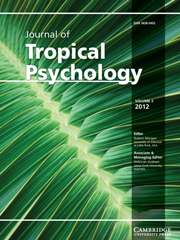Crossref Citations
This article has been cited by the following publications. This list is generated based on data provided by
Crossref.
Cheung, Hoi Shan
and
Elliott, John M.
2016.
Measuring Maternal Sensitivity: Cultural Variations in the Measurement of Emotional Availability.
Child Development,
Vol. 87,
Issue. 3,
p.
898.
Hawkins, Russell
and
Teng Sze Wei, Stephanie
2017.
Child Sexual Abuse Attributions Among Undergraduate Psychology Students in Singapore.
Journal of Child Sexual Abuse,
Vol. 26,
Issue. 7,
p.
839.
Nomanbhoy, Alefiya
and
Hawkins, Russell
2018.
Parenting practices of Singaporean mothers of children with ADHD.
Proceedings of Singapore Healthcare,
Vol. 27,
Issue. 1,
p.
33.
Shorey, Shefaly
Ang, Lina
and
Goh, Esther C.L.
2018.
Lived experiences of Asian fathers during the early postpartum period: Insights from qualitative inquiry.
Midwifery,
Vol. 60,
Issue. ,
p.
30.
Fries, Lisa R.
Chan, Mei Jun
Quah, Phaik Ling
Toh, Jia Ying
Fogel, Anna
Goh, Ai Ting
Aris, Izzuddin M.
Broekman, Birit F.P.
Cai, Shirong
Tint, Mya Thway
Chong, Yap Seng
Shek, Lynette P.
Lee, Yung Seng
Yap, Fabian
Tan, Kok Hian
Gluckman, Peter D.
Godfrey, Keith M.
Silva Zolezzi, Irma
Forde, Ciaran G.
and
Chong, Mary F.F.
2019.
Maternal feeding practices and children's food intake during an ad libitum buffet meal: Results from the GUSTO cohort.
Appetite,
Vol. 142,
Issue. ,
p.
104371.
BAL, Sümeyye
and
KOÇ, Gülten
2020.
BABALARIN BEBEK BAKIMINA KATILIMININ SAĞLANMASINDA HEMŞİRENİN ROLÜ.
Samsun Sağlık Bilimleri Dergisi,
Vol. 5,
Issue. 2,
p.
90.
Cho, Pamela Li Ying
Ong, Andrea Shi En
and
Cheung, Hoi Shan
2022.
Where authoritarianism is not always bad: Parenting styles and romantic relationship quality among emerging adults in Singapore.
Current Psychology,
Vol. 41,
Issue. 7,
p.
4657.
Cheung, Hoi Shan
and
Lim, Elinor
2022.
A scoping review of Singapore parenting: Culture‐general and culture‐specific functions of parenting styles and practices.
Infant and Child Development,
Vol. 31,
Issue. 4,
Ee, Chang Hui
Wen, Sng Qian
and
Shorey, Shefaly
2022.
Intergenerational Perspectives of Paternal Parenting Practices: A Descriptive Qualitative Study.
Journal of Family Issues,
Vol. 43,
Issue. 1,
p.
259.
Neoh, Michelle Jin Yee
Lieu, An An
Perinelli, Enrico
Balagtas, Jan Paolo Macapinlac
Nah, Hilda
Ho, Moon‐Ho Ringo
and
Esposito, Gianluca
2023.
An intergenerational study of parental bonding on perceptions of parental and spousal criticism and marital relationship quality in Singapore.
Family Process,
龙, 柯冰
2023.
Research on Parenting Styles and Children’s Psychological Development.
Advances in Social Sciences,
Vol. 12,
Issue. 04,
p.
1930.
Sudo, Mioko
Won, Ying Qing
Chau, Winnie W. Y.
Meaney, Michael J.
Kee, Michelle Z. L
Chen, Helen
Eriksson, Johan Gunnar
Yap, Fabian
Rifkin-Graboi, Anne
Tiemeier, Henning
and
Setoh, Peipei
2023.
Physical discipline as a normative childhood experience in Singapore.
Child and Adolescent Psychiatry and Mental Health,
Vol. 17,
Issue. 1,
Li, Lin
Liu, Han
Kang, Yupan
Shi, Yaojiang
and
Zhao, Zijian
2024.
The influence of parental involvement on students’ non-cognitive abilities in rural ethnic regions of northwest China.
Studies in Educational Evaluation,
Vol. 81,
Issue. ,
p.
101344.
Chen, Shi‐Min
Gao, Liang
Lin, Shi‐Hui
and
Zhang, Ying
2024.
Relationship between parental involvement and emotional well‐being in Chinese left‐behind children: A moderated mediation model.
Family Relations,
Vol. 73,
Issue. 2,
p.
1346.




